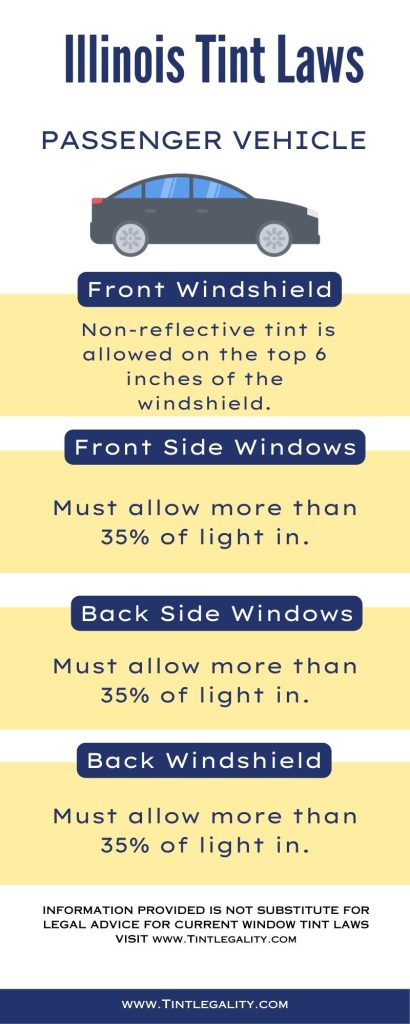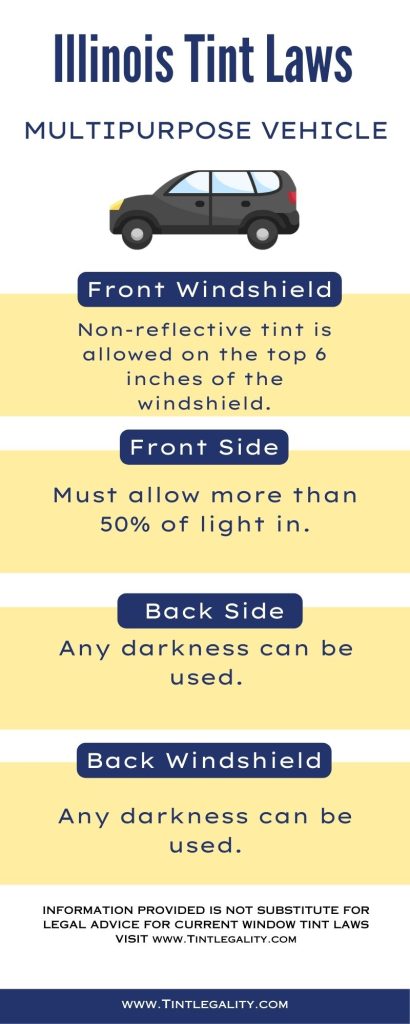Illinois tint laws were enacted to regulate the use of window tint in vehicles across the state.
These laws specify the allowable levels of darkness for window tinting and aim to ensure safety on the roads while considering factors such as visibility and law enforcement.
Understanding these regulations is crucial for vehicle owners and drivers in Illinois to avoid penalties and ensure compliance.
In this article, we will delve into the details of Illinois tint laws, covering various aspects such as windshield tinting, front and back side windows, rear windows, additional regulations, medical exemptions, color restrictions, side mirrors, and the penalties for non-compliance.
Illinois Tint Laws: An Overview
Illinois window tint laws vary depending on the type of vehicle you drive.
For instance, the laws for sedans and coupes differ from those for SUVs and vans.
The “tint darkness” is measured by the visible light transmission (VLT), which is the percentage of light allowed through your automobile’s window.
| Tint Regulations | Allowed Percentage |
|---|---|
| Windshield | Non-reflective tint on top 6 inches |
| Front Side Windows | More than 35% visible light transmission |
| Back Side Windows | More than 35% visible light transmission |
| Rear Window | More than 35% visible light transmission |
Windshield Tinting
When it comes to tinting the windshield, Illinois tint laws have specific regulations in place.
According to these laws, window tinting is allowed on the top 6 inches of the windshield.
However, the tint applied in this area must be non-reflective.
This means that the tint should not create a mirrored or metallic appearance, as it can impair visibility and increase the risk of accidents.
Front Side Windows
For the front side windows of vehicles in Illinois, there are strict regulations regarding tint darkness.
The window tint applied to the front side windows must allow more than 35% of the light to pass through.
This requirement ensures adequate visibility for both the driver and law enforcement officers.
Back Side Windows
Similar to the regulations for front-side windows, the tint applied to the back-side windows must also allow more than 35% of the light to pass through.
This requirement ensures visibility for the driver and passengers inside the vehicle while maintaining a balance between privacy and safety.
Rear Window
The regulations for the rear window tint in Illinois are consistent with those for the front and back side windows.
The tint applied to the rear window must allow more than 35% of the light to pass through.
This requirement ensures proper visibility for the driver, especially when using the rearview mirror, and allows law enforcement officers to observe the interior of the vehicle if necessary.


Additional Regulations
In addition to the specific regulations for windshields, front-side windows, back-side windows, and rear windows, Illinois tint laws encompass various other factors to ensure safety and compliance.
Reflection
Illinois prohibits the use of reflective window tint on vehicles.
Reflective tinting can create glare and compromise the visibility of other drivers on the road.
Therefore, it is important to avoid using window tint that has a mirrored or metallic appearance.
Medical Exemptions
Illinois recognizes that certain medical conditions may require individuals to have tinted windows for health reasons.
Conditions such as porphyria, Xeroderma Pigmentosum, lupus erythematosus, disseminated superficial actinic porokeratosis, and albinism may necessitate the use of window tint to protect individuals from the sun’s direct rays.
However, to qualify for a medical exemption, individuals must provide documentation from a licensed physician supporting their need for tinted windows.
Color Restrictions
Illinois tint laws do not impose specific restrictions on the color of window tint.
Vehicle owners have the freedom to choose the tint color that best suits their preferences and style.
Side Mirrors
If the back windows of a vehicle are tinted, Illinois requires the presence of dual side mirrors.
Dual-side mirrors compensate for reduced visibility due to darker tinted windows, allowing drivers to have a clear view of their surroundings and minimize blind spots.
Exceptions to Legal Limits
There are situations in which the legal limits for window tinting may not apply.
For example, certain law enforcement vehicles and vehicles used for medical transport may be allowed to have darker tint for security and safety purposes.
However, these exceptions are strictly regulated and apply only to specific types of vehicles and circumstances.
Penalties for Breaking the Law
Illinois takes the enforcement of tint laws seriously to maintain safety on the roads.
Violating the tint regulations can result in various penalties, including fines and potential consequences for vehicle inspections and registration.
Fines
The fines for violating Illinois tint laws can vary depending on the specific circumstances and the number of times the offense has been committed.
It is important to note that fines can increase for subsequent convictions.
| Penalties for Violation | Fine Range |
|---|---|
| First Conviction | $50 – $500 |
| Second Conviction | $100 – $500 |
| Third Conviction | Higher fines, potential license suspension |
First Conviction
For a first-time offense, the fine for violating tint laws can range from $50 to $500.
The exact amount depends on the severity of the violation and other factors considered by the law enforcement officer.
Second Conviction
If a driver is convicted of violating tint laws for a second time, the fine can be higher than the first offense.
The range for fines, in this case, is typically higher, starting from $100 and going up to $500.
Third Conviction
For repeat offenders who are convicted of violating tint laws for the third time, the fines can be significantly higher.
The penalties may exceed the previous amounts, and the driver may face more severe consequences, including the potential suspension of their driver’s license.
Other Penalties
In addition to fines, drivers who violate Illinois tint laws may face additional penalties, such as having their vehicle’s registration suspended or facing consequences during vehicle inspections.
These penalties aim to discourage non-compliance with tint regulations and ensure the safety of all road users.
Conclusion
Window tinting can provide various benefits, but it is crucial to balance personal preferences with legal requirements.
By following Illinois tint laws, drivers can enjoy the advantages of window tinting while promoting road safety and compliance with state regulations.
FAQs
Is 5% Tint Legal in Illinois?
No, 5% tint is not legal in Illinois.
Is 20 Percent Tint Legal in Illinois?
No 20% tint is not legal in Illinois.
How Much Is a Ticket for Tinted Windows in Illinois?
The ticket cost for tinted windows varies. Your fine can vary from $100 to $500, depending on the situation.
Can You Get Pulled Over for Tint in Illinois?
Yes, you can be pulled over for tint violations.
References: